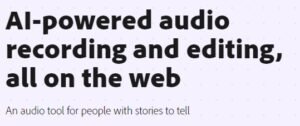Voice Noise remover are you tired of hearing unwanted background noise or static in your recorded voice? Whether you’re a podcaster, musician, or content creator, these pesky noises can diminish the quality of your work. But fear not! A voice noise remover could be just what you need to take your recordings to the next level. In this blog post, we’ll dive into what a voice noise remover is and how it works. We’ll also explore the different types available on the market and weigh their pros and cons. So let’s get started and eliminate that distracting background noise for good!

What is a voice noise remover?
A voice noise remover is a software tool designed to enhance the quality of audio recordings by reducing or removing background noise. It can be used in various settings such as podcasting, music production, video conferencing, and even phone calls.
The software works by analyzing the input signal and identifying any unwanted noises that are not part of the human voice. Once identified, it uses algorithms to isolate those sounds from the rest of the recording and removes them without affecting the quality of the intended audio.
There are different types of voice noise removers available on the market today. Some operate as standalone applications while others come bundled with digital audio workstations (DAW). There are also online services that offer this feature for free or with a subscription fee.
While some people prefer using hardware-based solutions like external microphones or soundproofing equipment, voice noise removers provide an affordable and convenient alternative. They save time by eliminating post-production editing tasks required to remove unwanted noises manually.
If you’re looking for an easy way to improve your audio recordings’ quality without breaking your budget, a voice noise remover could be just what you need!
How does a voice noise remover work?
It uses various algorithms and filters to analyze the sound waves and separate the desired speech signal from other noises such as wind, traffic, or humming.
The first step in this process is to capture the original recording with all its imperfections. The voice noise remover then analyzes the recorded audio for any unwanted sounds and separates them into distinct frequency bands. It then applies digital processing techniques like filtering, equalization, spectral subtraction, or adaptive thresholding to remove these undesired components.
Once the removal process is complete, it recombines all of the remaining desirable signals into a final file that can be saved as an MP3 or WAV format. The result should be a clean recording where only intended speech remains without any distracting background noise.
It’s important to note that not all types of background noise can always be removed completely by using voice noise removers. For instance, if there are multiple speakers talking simultaneously in different frequencies during recording – then it could become difficult for even advanced tools like Artificial intelligence-based beamforming microphones too!
The different types of voice noise removers
There are various types of voice noise removers available in the market, each with its own unique features and capabilities. The most commonly used type is software-based noise removal tools that can be installed on your computer or phone.
Another type of voice noise remover is a physical device that plugs into your microphone or recording equipment. These devices use advanced filtering technology to eliminate unwanted background noises.
Some voice noise removers are specifically designed for certain applications, such as podcasting or video conferencing. These specialized tools come equipped with additional features like echo cancellation and automatic gain control to provide crystal clear audio quality.
There are also online services that offer cloud-based noise removal solutions. These platforms allow you to upload your audio files and apply various filters to remove background noises quickly and easily.
Regardless of which type of voice noise remover you choose, it’s essential to ensure that it meets your specific needs and requirements. So make sure you do thorough research before investing in any particular tool or service!
Pros and cons of using a voice noise remover
Using a voice noise remover can have its advantages and disadvantages. On one hand, it can help improve the quality of audio recordings by removing unwanted background noises such as wind or traffic sounds. This can result in clearer speech and easier listening. Additionally, using a voice noise remover can save time during the editing process since manual removal of noise is often tedious and time-consuming.
However, there are also some drawbacks to using these tools. One potential issue is that they may remove too much from the recording, including important parts of the voice signal itself. This could result in distortion or loss of clarity in certain areas of the track.
Another concern is that using a voice noise remover may not always be accurate, especially if you’re dealing with complex soundscapes where multiple sources are present at once. In such cases, manual editing might still be necessary to achieve optimal results.
Some people feel that relying on technology too heavily takes away from their creative control over an audio project and prefer to manually edit out any unwanted sounds themselves – even if it means more work upfront.
While there are benefits to using a voice noise remover tool for audio projects involving spoken word content like podcasts or interviews – it’s important to weigh those against any potential downsides before deciding whether this approach best fits your needs as an editor or creator!
How to use a voice noise remover
Using a voice noise remover is not rocket science, but it requires some basic knowledge of the tool. The first thing to do when using a voice noise remover is to identify your input source. Is it a pre-recorded audio file or live audio from your microphone? Once you have identified your input source, import or record the audio into the software.
Secondly, adjust the settings of the voice noise remover according to your preference. Experiment with each filter until you find one that works best for removing unwanted sounds such as hissing, humming or background noises.
Thirdly, preview the filtered output before saving changes made by clicking on play button in software interface.
Save and export final output after checking all adjustments and ensuring that everything sounds clean and crisp without any noticeable distortion or loss of quality. With these simple steps in mind, anyone can effectively use a voice noise remover for their recordings and enjoy high-quality audio free from annoying background noises!
Voice Noise Remover Recipes
Voice noise remover recipes are DIY solutions that can help remove unwanted background sounds or noise from your audio recordings.
One popular recipe is to mix equal parts of water and white vinegar in a spray bottle. White vinegar helps remove any dirt, dust, or germs that may interfere with the quality of the recording.
Another recipe involves using baking soda mixed with warm water as a cleaning agent for the microphone. Baking soda has natural deodorizing properties which help eliminate any unpleasant odors that may affect your audio quality.
In addition to these cleaning solutions, you can also create homemade pop filters using materials such as pantyhose or wire mesh wrapped around an embroidery hoop. Pop filters help reduce popping sounds caused by plosive consonants like “p” and “b.”
Voice noise remover recipes offer simple yet effective ways to enhance your audio recordings without having to invest in expensive equipment or software.

Alternatives to Voice Noise Removers
While voice noise removers can be incredibly helpful in removing unwanted background sounds, there are also alternative methods to consider. One option is simply adjusting your recording environment to minimize or eliminate the sources of noise. This could mean finding a quieter space to record, using sound-absorbing materials like acoustic foam, or investing in a higher-quality microphone.
Another alternative is using audio editing software that includes noise reduction tools. Programs like Audacity and Adobe Audition offer features for reducing background noise without sacrificing the quality of your voice recordings.
It’s also worth noting that some video conferencing platforms have built-in noise suppression settings that can help reduce background noises during calls and meetings. For example, Zoom offers an option called “Suppress Background Noise,” while Google Meet has a similar feature called “Noise Cancellation.”
Ultimately, the best solution will depend on your specific needs and budget. While voice noise removers may be a convenient tool for some situations, exploring other options could lead to more effective and cost-efficient solutions over time.
Conclusion
To sum it up, Voice Noise Removers are a great tool for anyone who wants to improve the quality of their audio recordings, whether it be for professional or personal purposes. They work by reducing or eliminating unwanted background noise while preserving the clarity of the voice.
There are different types of voice noise removers available in the market which can cater to various needs and budgets.
Using a voice noise remover takes some practice and experimentation but once you get comfortable with it, you will see significant improvement in your audio quality. Sometimes even after removing background noises from an audio file through software like Audacity or Adobe Premiere Pro CC certain distortion remains due to overlapping frequencies between voices and sounds.
If you want cleaner sounding recordings without having to spend too much time editing then investing in a good quality Voice Noise Remover would definitely be worth considering!


